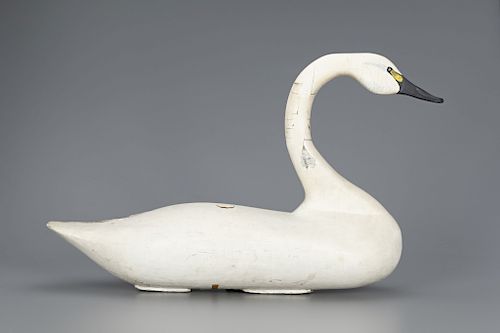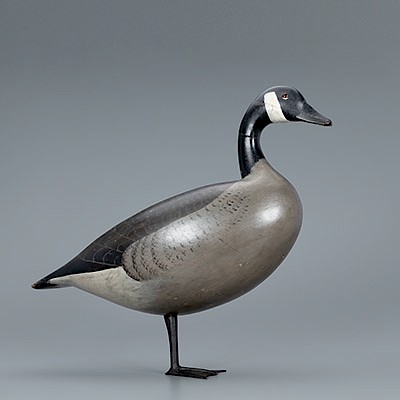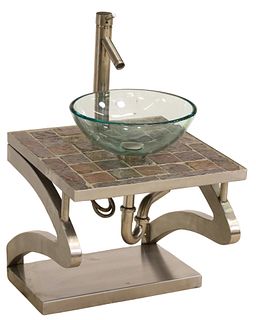The Gifford Holly Swan
Lot 170
About Seller
Copley Fine Art Auctions
20 Winter Street
Pembroke, MA 02359
United States
Founded in 2005, Copley Fine Art Auctions is a boutique auction house specializing in antique decoys and American, sporting, and wildlife paintings. Over the course of the last two decades, the firm has set auction records for not only individual decoy makers, but also entire carving regions. Copley...Read more
Estimate:
$65,000 - $85,000
Absentee vs Live bid
Two ways to bid:
- Leave a max absentee bid and the platform will bid on your behalf up to your maximum bid during the live auction.
- Bid live during the auction and your bids will be submitted real-time to the auctioneer.
Bid Increments
| Price | Bid Increment |
|---|---|
| $0 | $50 |
| $1,000 | $100 |
| $2,500 | $250 |
| $5,000 | $500 |
| $10,000 | $1,000 |
| $25,000 | $2,500 |
| $50,000 | $5,000 |
About Auction
By Copley Fine Art Auctions
Feb 16, 2019
Set Reminder
2019-02-16 10:00:00
2019-02-16 10:00:00
America/New_York
Bidsquare
Bidsquare : The Winter Sale 2019
https://www.bidsquare.com/auctions/copley/the-winter-sale-2019-3820
The sale will offer the opportunity to view and take home world-class paintings and fine bird carvings. Featuring selections from the collections of Alfred Ely, L. H. LaMonte, Grant Nelson, Ronald S. Swanson, Herb Wetanson, and a descendant of Chester F. Spear among others. Copley Fine Art Auctions cinnie@copleyart.com
The sale will offer the opportunity to view and take home world-class paintings and fine bird carvings. Featuring selections from the collections of Alfred Ely, L. H. LaMonte, Grant Nelson, Ronald S. Swanson, Herb Wetanson, and a descendant of Chester F. Spear among others. Copley Fine Art Auctions cinnie@copleyart.com
- Lot Description
The Gifford Holly Swan
John "Daddy" Holly (1818-1892) or James T. Holly (1855-1935)
Havre de Grace, MD, c. 1885
20 in. tall by 34 3/4 in. long
“The Holly family is best known as the originator of the Havre de Grace Style of decoy carving. Their style of smooth flowing bodies with upswept tails is synonymous with the thousands of decoys that come from the Havre de Grace side of the Susquehanna River Flats as they flow into the Chesapeake Bay. “The most prolific and most artistic of the Holly family was James T. Holly (1855-1935). He built sinkboxes and bushwhacks boats, painted duck shooting scenes and sailing vessels, and carved most species of waterfowl that frequented the Upper Chesapeake. His decoys exhibit the sleekest and raciest style of any of the carvers from this region. The rarest of his carvings are his magnificent full size swan decoys. The very few known examples exhibit the most fluid sculpted bodies of any of the Chesapeake swans. The Gifford Holly Swan presents itself as a once-in-a-lifetime opportunity for not just dedicated waterfowling historians but connoisseurs as well.” - C. John Sullivan
C. John Sullivan is an authority on the history of the Upper Chesapeake Bay and its decoys. He has served as a consultant to the Maryland Historical Society, the Ward Museum of Wildfowl Art, the Havre de Grace Decoy Museum, and the Chesapeake Bay Maritime Museum. As an author, Sullivan has published over a dozen volumes, including "Waterfowling: The Upper Chesapeake’s Legacy," "Decoys and Stories," and, most recently, "Waterfowling on the Chesapeake, 1819-1936." He also co-authored the Havre de Grace Decoy Museum Collection book “Captured in Wood” and has published numerous articles.
Many consider the form of these early swans from Havre de Grace, Maryland to be the finest from any region. There are only five documented examples of these birds attributed to John “Daddy” Holly, James T. Holly, and Sam Barnes (1857-1926) known to exist. In addition to The Gifford Holly Swan, two of these five are held in distinguished private collections. Of these, one originates from the Thomas Eshenbaugh Collection, and was subsequently acquired by Thomas K. Figge as the number one pick out of the William Butler collection. That decoy now resides in one the world’s top collections, that of Paul Tudor Jones II (see fig.1). The other was collected by a top Southern decoy collector and now resides in the Henry H. Stansbury Collection (see fig. 2). That decoy, illustrated in J. Evans McKinney’s Decoys of the Susquehanna Flats and Their Makers, is the same length as the Gifford swan, measuring 34 ¾ inches long.
A fourth comparable example, collected by Joel Barber, is held in the permanent collection of the Shelburne Museum, Shelburne, Vermont (see fig. 3). The final example resides in the collection of the Chesapeake Bay Maritime Museum in St. Michaels, Maryland (see fig. 4).
Earlier attributions to some of these swan decoys have been given to fellow Havre de Grace decoy maker Sam Barnes (1857-1926). While Barnes was a highly accomplished carver in his own right, a comparison of each maker’s bills, heads, and tails clearly reveals the Gifford, Eshenbaugh, andStansbury swans to be the work of the Hollys. A close examination of their bill carving shows a level of refinement not found on any Barnes decoy.
This important gunning decoy reveals all the carving nuances of the maker as well as the species with a graceful neck that flows to a pronounced breast, creating an “S” curve. The base of the head flares where it meets the slightly raised neck shelf, and the gentle arc of the back dips before sweeping to an uplifted rounded tail. The sides of the bird drop into a V-hull that flattens at the very bottom.
Fellow Maryland carver Severn W. Hall (1909-1995) discusses this exact Holly swan in great detail in a three-page letter to Dr. G. Edmund Gifford, dated September 22, 1975. Dr. Gifford had purchased the decoy from Lou Pennock (1888-1969) of Greenbank, Maryland. Hall recounts a period from his childhood, from age nine to seventeen (1919-1927), when he played and helped around the wharves of North East Creek.
“Some of us would often wander into the old dilapidated shed owned and used by Capt. Frank Jackson (deceased) [1873-1934] for storing the remains (off-season remnants) of his assorted marine equipment, fish nets and his sink-box ducking rig. Never once can I recall Cap’t Frank reprimanding us immatures when we chose to drag out the two old swan decoys and ride on then [sic] as a make-believe hobby horse or for what ever purpose our imagination had to offer at the time.
“After I graduated from High School in 1926 until approxiately [sic] 1947, memories of the juvenile pleasures associated with those two swan decoys were passé, mindless personally speaking.
“So be it, I was greatly involved from the early 1940’s up until October 1959 in making, repairing and painting duck and geese decoys. Lo and behold, as mention above and being more exacting; September 1947 Lou P. (Pennock) loitered into my little shop at 4 Thomas Avenue, N. East, Md. He had an old swan decoy under one arm and its original wooden head in several pieces. The total of all the image was in a bad state of repair. Lou P. asked for rather inquired of me as to whether I would fix it up and paint it in my spare time for him. Knowing and recognizing him with respect as being an experienced Susquehanna Flats wild gunner and guide, by this he was able to hold my attention on the subject at hand. So in the concordant conversation I ask him where he got decoy. Lou P. informed me that he had gotten it from Cap’t Frank Jackson. As I recall after hearing this my enthusiam [sic] was inspired to a point of visualizing, that this was one of those two swan decoys that highlighted my young attention years ago.”
Hall agreed to repair the swan and, several weeks later, returned the decoy to Pennock. From the archives of Dr. G. Edmund Gifford, Jr. (1930-1981), it is known that Gifford purchased this swan directly from Pennock prior to 1969.
Knowing he had something special, Dr. Gifford researched this swan in earnest. A graduate of the University of Maryland, Gifford was an amateur botanist, enthusiastic birdwatcher, and avid historian. He wrote dozens of scholarly essays, many revolving around his fellow naturalists, including “John James Audubon’s Baltimore Physician Patrons” and “John James Audubon and His Charleston Physician Friends.” He also published the book “Cecil County, Maryland, 1608-1850: As Seen By Some Visitors, and Several Essays on Local History.”
Always intrigued by Maryland’s rich waterfowling heritage, and this bird in particular, Dr. Gifford contacted the Historical Society of Cecil County in December 1979, sending them a photograph of the swan he had acquired from Pennock. The president of the Society responded excitedly asking:
“I wonder if you have considered donating the swan decoy to the Society, or perhaps lending it to us for some specific length of time for display. I’m not sure how many people now living in this area who are decoy buffs have actually seen a Sam Barnes [Holly] swan.”
Dr. Gifford, however, politely declined. The underside retains remnants of a label identifying the decoy as “Property of Dr. George Gifford.”
Gifford also learned of the famous Holly swan at the Shelburne Museum from the Barber Collection. The 1961 publication Decoys at Shelburne Museum reports that their iconic decoy “...has been seen by more people, either in photographs or in actuality, than any other American decoy.” The authors continue, “Probably the most photographed decoy in America at this writing, it has been exhibited in countless shows in this country and in 1958 was on display at the Brussels Universal and International Exhibition.” In recounting the discovery of his Holly swan, Barber states, “...I am a collector, and swan decoys are the rarest of them all. It seemed to me that day that I had discovered, to quote Frank Forester: ‘The King of waterfowl—the superb and incomparable Wild Swan.”
The beauty of form, provenance, condition, and rarity of this swan place it as a pinnacle carving of the species. In excellent gunning paint with neck reset by Severn Hall in 1947. The bird features a pleasing patina with even craquelure, and gunning wear, including some flaking, mostly to head, back, and tail.
Provenance: Sinkbox gunning rig of Captain Frank Jackson, North East, Maryland
Lou Pennock Rig, Greenbank, Maryland, acquired from the above
Dr. George Edmund Gifford, Jr. Collection, acquired from the above
Private Collection, by descent in the family
Private Collection, Pennsylvania, acquired 2009
Literature: Frank Maresca & Roger Ricco, "American Vernacular," New York, NY, 2002, p. 37, related example illustrated.
C. John Sullivan, “The Hollys of Havre de Grace,” Decoy Magazine, Jan/Feb 1992, pp. 8-13. Joel Barber, "Wild Fowl Decoys," Garden City, NY, 1936, p. 134, and pl. 1 and 104, related example illustrated.
Linda and Gene Kangas, "Decoys," Paducah, KY, 1992, pp. 161 and 262-263, pl. C-2, 481, 485, related examples illustrated. Adele Earnest, "The Art of the Decoy: American Bird Carvings," New York, NY, 1965, p. 82. David S. Webster and William Kehoe, "Shelburne Museum Decoys," Shelburne, VT, 1961, pp. 98-99, related example illustrated.
Joe Engers, ed., "The Great Book of Wildfowl Decoys," San Diego, CA, 1990, pp. 138-139, related example illustrated.
J. Evans McKinney, "Decoys of the Susquehanna Flats and Their Makers," Ocean City, MD, 1990, pp. 14, 21, related example illustrated.
Joe Engers, "Chesapeake Bay Gunning Decoys," Maryland Magazine, Autumn 1991, pp. 18-19, related example illustrated. Copley Fine Art Auctions, "The Sporting Sale 2009," July 15-16, 2009, lot 228 and back cover, exact decoy illustrated.
Robert Shaw, "Bird Decoys of North America," New York, NY, 2010, spine of dust jacket and p. 27, related example illustrated. Paul A. Johnsgard, "The Bird Decoy: An American Art Form," Lincoln, NE, 1976, title page and p. 24, fig. 2, closely related example illustrated.
R. H. Richardson, “Chesapeake Bay Decoys,” Cambridge, MD, title page, closely related example illustrated.Condition report requests can be made via email or by telephone (info@copleyart.com or 617.536.0030). Any condition statement given is a courtesy to customers, Copley will not be held responsible for any errors or omissions. The absence of a condition statement does not imply that the lot is in perfect condition.Condition
- Shipping Info
-
Shipping info
Copley Fine Art Auctions does not handle the shipping of any items. Shipping is the sole responsibility of the buyer. Once your payment has cleared, and we have received your authorized shipping release form items may be released for shipment. Copley Fine Art Auctions, LLC shall have no liability for any loss or damage to such items. Buyers should allow up to four weeks for shipment.Please be aware that internet bidders may NOT not pick up their items at the sale. Items will be available for pick up by appointment or by shippers five days after the sale.
-



 EUR
EUR CAD
CAD AUD
AUD GBP
GBP MXN
MXN HKD
HKD CNY
CNY MYR
MYR SEK
SEK SGD
SGD CHF
CHF THB
THB














